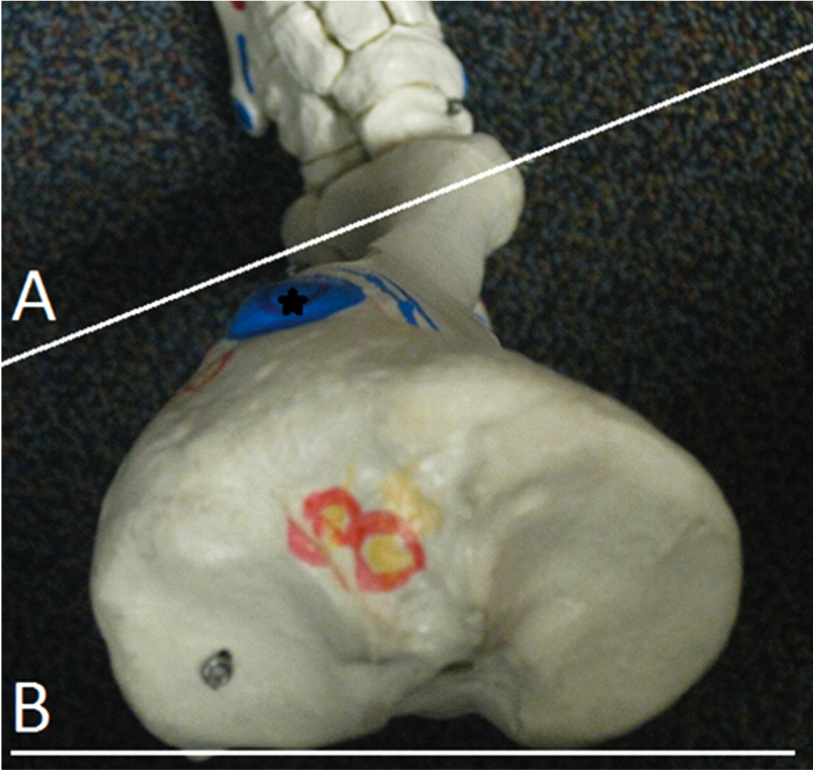Yes, we are all twisted; Part 3
In the last 2 posts we discussed the differences between torsions and versions, as well as talar version and torsion, 1 of the 3 major versional events that occur during normal development (missed out? Click here and here to re read them).
In this post we discuss tibial versions and torsions.
The tibia and femur are more prone to torsional defects, as they are longer lamellar (layered) bones as opposed to the cancellous bone that makes up the talus. These often present as an “in toeing” or “out toeing” of the foot with respect to the leg; changing the progression angle of gait (click here for more on progression angles).
Tibial versions and torsions can be measured by the “thigh foot angle” (the angulation of the foot to the thigh with the leg bent 90 degrees: above right) or the “transmalleolar angle” (the angle that a line drawn between the medial and lateral malleoli of the ankle makes with the tibial plateau: above left).
At a gestational age of 5 months, the fetus has approximately 20° of internal tibial torsion. As the fetus matures, The tibia then rotates externally, and most newborns have an average of 0- 4° of internal tibial torsion. At birth, there should be little to no torsion of the tibia; the proximal and distal portions of the bone have little angular difference (see above: top). Postnatally, the tibia should twist outward (externally) a total of 15 degrees until adult values are reached between ages 8 and 10 years of 23° of external tibial torsion (range, 0° to 40°).
Sometimes the rotation at birth is excessive. This is called a torsion. Five in 10,000 children born will have rotational deformities of the legs. The most common cause is position and pressure (on the lower legs) in the uterus (an unstretched uterus in a first pregnancy causes greater pressuremaking the first-born child more prone to rotational deformities. Growth of the unborn child accelerates during the last 10 weeks and the compression from the uterus thus increases. As you would guess, premature infants have less rotational deformities than full-term infants. This is probably due to decreased pressure in the uterus. Twins take up more space in the uterus and are more likely to have rotational deformities.
Of interesting note, there is a 2:1 preponderance of left sided deformities believed to be due to most babies being carried on their backs on the left side of the mother in utero, causing the left leg to overlie the right in an externally rotated and abducted position.
Normal ranges of versions and torsions are highly variable (see chart above: right). Ranges less than the values are considered internal tibial torsion and greater external tibial torsion.
Internal tibial torsion (ITT) usually corrects 1 to 2 years after physiological bowing of the tibia (ie tibial varum) resolves. External tibial torsion (TT) is less common in infancy than ITT but is more likely to persist in later childhood and NOT resolve with growth because the natural progression of development is toward increasing external torsion.
Males and females seem to be affected equally, with about two thirds of patients are affected bilaterally and the differences in normal tibial version values are often expected to be cultural, lifestyle and posture related.
The ability to compensate for a tibial torsion depends on the amount of inversion and eversion present in the foot and on the amount of rotation possible at the hip. Internal torsion causes the foot to adduct, and the patient tries to compensate by everting the foot and/or by externally rotating at the hip. Similarly, persons with external tibial torsion invert at the foot and internally rotate at the hip. Both can decrease walking agility and speed if severe. With an external tibial torsion deformity of 30 degrees , the capacities of soleus, posterior gluteus medius, and gluteus maximus to extend both the hip and knee were all reduced by over 10%.
Well, that was probably more than you wanted to know about tibial torsions, and we could go on for many more pages and perhaps cure any insomnia you may have. Take a while to digest this, as it is important to gait, shoe selection, and rehabilitation. Torsions are an acquired taste and we hope we have whetted your appetite! Tomorrow we talk about compensations!
Ivo and Shawn; two twisted guys!
All material copyright 2013 The Gait Guys/ The Homunculus Group. All rights reserved. Ask before you lift our stuff, Lee is watching……





































